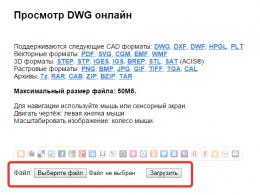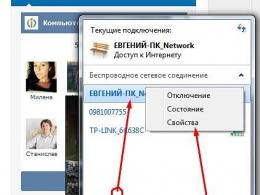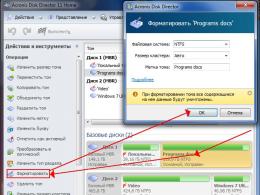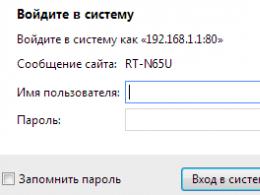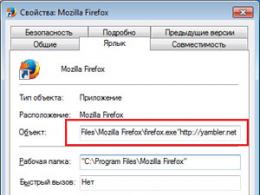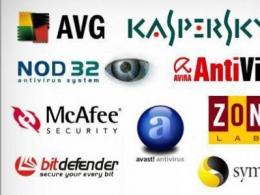The command to show all is called by the key. Most Useful Windows Keyboard Shortcuts (Hotkeys)
In the operating room Windows system 7, a number of new keyboard shortcuts (hot keys) appeared. The use of hotkeys makes working at the computer more convenient, significantly speeds up the process and saves valuable time.
Keyboard shortcut |
Description |
|---|---|
| Ctrl + Esc Win |
Open the Start Menu |
| Ctrl + Shift + Esc | Call "Task Manager" |
| Win+E | Launching Explorer |
| Win+R | Displaying the dialog "Start the program" (Run), analogous to "Start" - "Run" |
| Win+D | Minimize all windows or return to the initial state(switch) |
| Win+L | Workstation lock |
| Win+F1 | Accessing Windows Help |
| win+pause | Calling the System Properties window |
| Win+F | Open file search window |
| Win + Ctrl + F | Open computer search window |
| Printscreen | Take a screenshot of the entire screen |
| Alt+printscreen | Take a screenshot of the current active window |
| Win+Tab Win + Shift + Tab |
Switches between buttons on the taskbar |
| F6 Tab |
Move between panels. For example, between desktop and Quick Launch |
| Ctrl+A | Select all (objects, text) |
| ctrl+c Ctrl+Insert |
Copy to clipboard (objects, text) |
| Ctrl + X Shift+Delete |
Cut to clipboard (objects, text) |
| Ctrl+V Shift+Insert |
Paste from clipboard (objects, text) |
| Ctrl + N | Create new document, project or similar action. V Internet Explorer this results in a new window opening with a copy of the contents of the current window. |
| ctrl+s | Save the current document, project, etc. |
| Ctrl+O | Call a file selection dialog to open a document, project, etc. |
| ctrl+p | Seal |
| Ctrl + Z | Undo last action |
| Shift | CD-ROM autorun lock (hold while drive reads newly inserted disc) |
| Alt+Enter | Switching to full screen mode and back (switch; for example, in Windows Media Player or in a shell window). |
Work with text.
Keyboard shortcut |
Description |
|---|---|
| Ctrl+A | Select all |
| ctrl+c Ctrl+Insert |
Copy |
| Ctrl + X Shift+Delete |
To cut |
| Ctrl+V Shift+Insert |
Insert |
| Ctrl + ← ctrl + → |
Transition by words in the text. Works not only in text editors. For example, it is very convenient to use address bar browser |
| Shift + ← Shift + → Shift + Shift + ↓ |
Text selection |
| Ctrl + Shift + ← Ctrl + Shift + → |
Selecting text by words |
| Home End Ctrl+Home Ctrl+End |
Move to the beginning-end of a line of text |
| Ctrl+Home Ctrl+End |
Move to the beginning-end of the document |
Working with files.
Keyboard shortcut |
Description |
|---|---|
| Shift+F10 Menu |
Display context menu current object (similar to pressing right click mice). |
| Alt+Enter | Calling "Object Properties" |
| F2 | Renaming an object |
| Drag with Ctrl | Copying an object |
| Drag with Shift | Moving an object |
| Drag with Ctrl + Shift | Create an object label |
| Clicks with Ctrl | Selecting Multiple Objects in Random Order |
| Clicks with Shift | Selection of several adjacent objects |
| Enter | Same as double clicking on an object |
| Delete | Deleting an object |
| Shift+Delete | Permanently deleting an object without placing it in the trash |
Work in the conductor.
Keyboard shortcut |
Description |
|---|---|
| F3 or Ctrl+F | Show or hide the search bar in File Explorer (toggle). |
| ← → + (on numeric keypad) − (on numeric keypad) |
Navigating through the explorer tree, folding-expanding nested directories. |
| * (asterisk) (on numeric keypad) | Display all folders nested in the selected folder |
| F5 | Refresh the File Explorer or Internet Explorer window. |
| backspace | Go up a level in a File Explorer or Internet Explorer window. |
| F4 | Go to the address bar of File Explorer or Internet Explorer. |
Working with windows.
Keyboard shortcut |
Description |
|---|---|
| Alt + Tab Alt + Shift + Tab |
Calling the transition menu between windows and moving through it |
| Alt + Esc Alt + Shift + Esc |
Move between windows (in the order they were launched) |
| Alt+F6 | Switching between multiple windows of the same program (for example, between open windows winword) |
| Alt+F4 | Close the active window ( running application). On the desktop - call the Windows shutdown dialog |
| Ctrl+F4 | Closing the active document in programs that allow multiple documents to be open at the same time |
| alt F10 |
Calling the window menu |
| Alt + − (minus) | Calling the system menu of a child window (for example, a document window) |
| Esc | Exit the window menu or close an open dialog |
| Alt + letter | Calling a menu command or opening a menu column. The corresponding letters in the menu are usually underlined (either initially or become underlined after pressing Alt). If the menu column is already open, then to call the desired command, you must press the key with the letter that is underlined in this command |
| Alt+Space | Calling the window system menu |
| F1 | Call application help. |
| Ctrl+Up Ctrl+Down |
Vertical scrolling of text or moving up and down paragraphs of text. |
Working with dialog boxes.
Keyboard shortcut |
Description |
|---|---|
| Ctrl+Tab | Move forward through tabs |
| Ctrl+Shift+Tab | Navigate back through tabs |
| Tab | Move forward through options |
| Alt + underlined letter | Executing the appropriate command or selecting the appropriate option |
| Enter | Execute a command for the current option or button |
| Arrow keys | Selecting a button if the active option is included in a radio button group |
| Shift + Tab | Navigating back through options |
Work in Internet Explorer.
Keyboard shortcut |
Description |
|---|---|
| F4 | Displaying a list of the "Address" field |
| Ctrl + N F5 |
Launch another browser instance with the same web address |
| ctrl+r | Refreshing the current web page |
| ctrl+b | Opens the Arrange Favorites dialog box |
| Ctrl+E | Opens the Search panel |
| ctrl+f | Starting the search utility |
| Ctrl+I | Opens the Favorites panel |
| Ctrl+L | Opens the "Open" dialog box |
| Ctrl+O | Opens the Open dialog box, similar to the Ctrl+L action |
| ctrl+p | Opens the Print dialog box |
| Ctrl+W | Close current window |
| F11 | Switch to full screen mode and back (works in some other applications). |
Special abilities.
- Press the SHIFT key five times: Turn Sticky Keys on or off
- Hold down the right SHIFT key for eight seconds: Enable or disable input filtering
- Hold down the Num Lock key for five seconds: Toggle toggle sound on and off
- Left Alt + Left Shift + Num Lock: Enable/disable keyboard pointer control
- Left Alt + Left Shift + PRINT SCREEN: Turn high contrast on and off
In this tutorial, you will find the main Windows 7 hotkeys, after reading, you will use your computer much more efficiently than you used it before.
Hotkeys is the way the keyboard interacts with the computer. This method consists in executing commands (operations) on the computer using keys or a combination of keys to which commands (operations) are programmed.
It is very difficult to get used to the new, so you should not start memorizing all the keys. To begin with, take 10-20 pieces for application, and then use others, so to speak, expanding your knowledge. It is also worth paying attention to the fact that each program can use its own hot keys, which are programmed by the developers of this program.
If you use Windows 7 hotkeys every day, at least 10 of them, you will notice how much more efficient your work will become. See the list of hotkeys in Windows 7 below.
Hotkey List
Hotkeys for working with text and files
I advise you to use the hotkeys that are in this section, be sure to learn and use them always.
Ctrl + C– Copy selected elements.
Ctrl+A- Select all. If you are in a text document, then when you press these keys, you will select all the text, and if in a folder where there are other objects, then you can select all files and folders.
Ctrl + X- To cut. The command cuts the selected elements (files, folders or text).
Ctrl+V- Insert. Paste copied or cut elements.
Ctrl+Z- Cancel. Cancel actions, for example, if text was accidentally deleted in MS Word, then using these keys you will return the original text back (cancel input and actions).
ALT+ ENTER or ALT + Double-click the left mouse button– View the property of the selected element(s) (applicable for files).
CTRL+F4- Close the current window in the program.
Deleting files and text
Delete- Delete the selected item(s). If you use this key in the text, then by placing the mouse cursor in the middle of the word and pressing the "Delete" button, the deletion will occur from left to right.Shift+Delete- Delete the item(s) bypassing the trash. For files and folders.
backspace- Removing text. If you are working in text editor, then this key can be used to delete text, place the cursor, let's say in the middle of a sentence, by pressing the "Backspace" button, deletion will occur from right to left.
Other
![]() - Open the start menu or CTRL+ESC, the button is usually located between the buttons CTRL and ALT.
- Open the start menu or CTRL+ESC, the button is usually located between the buttons CTRL and ALT.
![]() +F1- Reference.
+F1- Reference.
![]() + B- Move cursor to tray.
+ B- Move cursor to tray.
![]() +M- Minimize all windows.
+M- Minimize all windows.
![]() + D- Show desktop (minimize all windows, and maximize windows when pressed again).
+ D- Show desktop (minimize all windows, and maximize windows when pressed again).
![]() + E- Open My Computer.
+ E- Open My Computer.
![]() + F- Open the search box.
+ F- Open the search box.
![]() + G- Show gadgets on top of windows.
+ G- Show gadgets on top of windows.
![]() + L- Lock the computer. If you move away from the computer, then be sure to use these keys to quickly lock the computer. Very useful if you have children or ill-wishers who can read your personal information.
+ L- Lock the computer. If you move away from the computer, then be sure to use these keys to quickly lock the computer. Very useful if you have children or ill-wishers who can read your personal information.
![]() + P– Projector control. If a projector is connected, these keys allow you to quickly switch between the projector and the computer.
+ P– Projector control. If a projector is connected, these keys allow you to quickly switch between the projector and the computer.

![]() + R- Open the "Run" window.
+ R- Open the "Run" window.
![]() + T- In turn, we sequentially translate the focus on the icons that are in the taskbar.
+ T- In turn, we sequentially translate the focus on the icons that are in the taskbar.

![]() + U– Open the Center accessibility».
+ U– Open the Center accessibility».
![]() + X– Call "Mobility Center" (laptops and netbooks).
+ X– Call "Mobility Center" (laptops and netbooks).

![]() + Tab– Call "Flip 3D". When clicked, you can use the mouse to select a window.
+ Tab– Call "Flip 3D". When clicked, you can use the mouse to select a window.

![]() + Space– Desktop View (Aero Peak). All windows will become transparent.
+ Space– Desktop View (Aero Peak). All windows will become transparent.
![]() + Arrow– Controlling the location of the active window. Pressing the arrow up - maximize, down - collapse, left - stick to the left edge, right - stick to the right edge.
+ Arrow– Controlling the location of the active window. Pressing the arrow up - maximize, down - collapse, left - stick to the left edge, right - stick to the right edge.
![]() + Pause- Open the "System Properties" window.
+ Pause- Open the "System Properties" window.
![]() +Home— Minimize all windows except the active window, clicking again will open minimized windows. + 5, the player will open.
+Home— Minimize all windows except the active window, clicking again will open minimized windows. + 5, the player will open.
Alt + Tab (Tab)– Switching between windows and applications.
Shift+Ctrl+N- Create a new folder.
SHIFT+ F10– Display options for the selected element.
Shift + Arrow - Selection . Arrows are used: left, right, down and up. Applicable for text and files.
CTRL- Selection of elements. By holding CTRL you can selectively select items. For example, while in a folder, left-click on the folders that you want to copy or cut, after selection, release CTRL and get the folders you selected for further work with them.
Ctrl + Shift + Esc- Open task manager.
CTRL+TAB– Go forward through the bookmarks.
Alt + F4– Close the window or exit the application.
ALT + Space- Display the system menu for the current window.
F2- Rename. Select the object and press the F2 button .
F5- Refresh window. It is often used in the browser if the page is "hanging" or information needs to be updated. Applicable also if you are in a folder or program.
F10- Activate the menu.
Esc- Cancel the operation. When you open, for example, the properties of a folder by pressing the ESC button, the "Properties" window will close.
ENTER– Open the selected element.
TAB- Go ahead through the options.
P.S. Dessert for today, video about Windows 7 hotkeys.
Greetings, dear readers of the Rabota-Vo.ru blog! I won't be mistaken if I say that many ordinary users when sitting at the computer, never use Hotkeys. Most control their computer by manipulating the mouse. Even many of my friends, to whom I showed some key combinations for the speed and convenience of working at a computer, did not immediately understand what was the point of using them.
The force of habit does not allow many to give up what they are used to. That's the way man is. But, having tried several times to perform this or that operation on the computer, using keyboard shortcuts, after a while, many begin to use them automatically. I hope that the recommendations listed below on using the keys on the keyboard will be useful to someone and make it easier to stay at the computer.
Keyboard shortcut.
Hotkeys allow users to optimize their work on the computer and not interrupt the creative process for any nonsense. Using standard keyboard shortcuts, you can quickly execute the necessary commands (undo an action, copy and paste text, take a screenshot of the screen, switch the language, and even turn off the computer) without being distracted or even looking at the keyboard. By the way, Windows hotkeys work in almost all applications of this operating system. It doesn't matter if you're running Windows 7 or Windows XP. I will give a simple example of how the undo hotkeys "Ctrl" + "Z" work. To undo the last action, press the left key "Ctrl" and, holding it, press the English key "Z". If you want to undo multiple actions, press the "Z" key several times. Moreover, it does not matter what language you have enabled. Most often keyboard shortcuts work the same way in Russian and in English layout.
![]() Keys on the keyboard for searching.
Keys on the keyboard for searching.
It is very convenient to use the search keys "Ctrl" + "F". They allow you to quickly find a phrase in a document, and work with text is greatly simplified. By the way, search keys can also be used on site pages. When you press "Ctrl" + "F", at the top right in Google Chrome(top left in Opera, bottom left in Mazilla) a small box will appear where you can enter the word or phrase you want to search for on the page. If such a word is on the page, it will be highlighted in your browser in yellow or orange. The same line will contain the number of words found on the page, as well as arrows that allow you to quickly move to the next option. Just don't confuse hot keys search with site search. They only work on the page that is open in your browser.
 How to highlight text using the keyboard.
How to highlight text using the keyboard.
Keyboard shortcuts are also used to select text. For example, if the text document is very large and needs to be fully selected, use mouse cursor not very convenient. It's much easier to press "Ctrl" + "A" and all the text will be selected. To select a piece of text from the cursor to the left or right, press the "Shift" key and, while holding it, press the "←" and "→" arrows. Each time you press the arrow, the next letter will be highlighted. True, it takes a long time to highlight the text in this way, but it can come in handy. And to select text from the cursor to the beginning or to the end of the line, you can use the combinations "Shift" + "Home" and "Shift" + "End". In the same way, you can select text from the cursor in whole lines, up or down. To do this, place the cursor in the right place, press the "Shift" key and, while holding it, use the "" and "↓" arrows. By the way, pressing the opposite arrow removes the selection. To remove the selection, you can click anywhere in the open document. In some applications, you can deselect using the "Ctrl" + "D" keys, but they do not work everywhere. For instance, virtual keyboard it does not respond to this combination.
 How to copy text using the keyboard.
How to copy text using the keyboard.
Many are also interested what keys to copy in different applications. To do this, use the combination "Ctrl" + "C". The keys work the same way text documents, v graphic editors and in other programs. It is enough to select the desired fragment with the cursor and copy with the keys. Moreover, these keyboard keys are used to copy some files. But there is one caveat. If you want to copy text published on some site, you may not be able to. This is the copy protection of the text that the owner of the resource has set. About, how to copy non-copyable text from such sites, is described in more detail in another material.
 How to paste text using the keyboard.
How to paste text using the keyboard.
To paste text from the clipboard, you can press the hotkeys "Ctrl" + "V". They also work in different applications. you can use insert hotkeys in text documents or when copying a file. It is especially convenient with their help to insert a large number of identical objects (for example, characters that you want to use many times in a document).
 How to switch the keyboard to English.
How to switch the keyboard to English.
We switch the keyboard from Russian to English and vice versa a hundred times a day without even noticing it. Most often we use language switcher RU / EN, which is located at the bottom of the screen, on the right, on the taskbar. But it is much more convenient to do this using the Alt + Shift key combination. Over time, you start using these keys automatically. You just keep typing on the keyboard and don't think about how to switch to english and back.
 How to restart your computer using the keyboard.
How to restart your computer using the keyboard.
There is another key combination that you need to know. If the computer freezes and does not respond to your actions, press the "Ctrl" + "Alt" + "Del" keys at the same time. The Task Manager window will open, listing all the applications you have running. If you see the status “Not working” opposite any of them, click on the “End task” button.

If the mouse does not work, use the "Tab" key to select. When the End Task button is highlighted, press Enter. You also need to know what keys you can log out of the system if your mouse is broken. So to reload quickly or at all turn off computer, press the Windows key. It is located at the bottom, on both sides of the keyboard, it shows the logo of this operating system. When the main menu window appears, press the "↓" key until the "Shutdown" button is highlighted. Press "Enter", the standard window "Turn off the computer" will appear. Use the keys "←" and "→" to select the command "Shutdown" or "Reboot" and press "Enter". To cancel this action and return to the system, press "Esc".
Of course, there are other options for keyboard shortcuts to perform various operations on the computer. But in this note, I shared the most common ones that I use all the time myself and recommend to you, my readers. I wish you all good luck! See you soon on the Rabota-Vo.ru blog pages!
Good day.
Have you ever wondered why the same operations in Windows different users spend different time? And the point here is not the speed of possession of the mouse - just some use the so-called Hotkeys(replacing several mouse actions), while others, on the contrary, do everything with the mouse (edit / copy, edit / paste, etc.).
Many users do not attach importance to keyboard shortcuts (note: several keys pressed simultaneously on the keyboard) meanwhile, with their use - the speed of work can be increased at times! Generally, various combinations there are hundreds of keys in Windows, it makes no sense to memorize and consider all of them, but I will give the most convenient and necessary ones in this article. I recommend to use!
Note: In the various key combinations below, you will see a "+" sign - you do not need to press it. Plus in this case indicates that the keys must be pressed at the same time! The most useful hotkeys are marked in green.
Keyboard shortcuts with ALT:
- Alt + Tab or Alt + Shift + Tab- window switching, i.e. make the next window active;
- ALT+D- selection of text in the address bar of the browser (usually, then the combination Ctrl + C is used - copy the selected text);
- Alt+Enter- see "Properties of the object";
- Alt+F4- close the window with which this moment work;
- Alt+Space(Space is the spacebar) - call the window system menu;
- Alt + PrtScr- take a screenshot of the active window.
Keyboard shortcuts with Shift:
- Shift + LMB(LMB = left mouse button) - selection of several files or a piece of text (just hold down the shift key, put the cursor in the right place and move the mouse - the files or part of the text will be selected. Very convenient!);
- Shift+Ctrl+Home- select to the beginning of the text (from the cursor);
- Shift+Ctrl+End- select to the end of the text (from the cursor);
- Shift button pressed- blocking CD-ROM autorun, the button must be held while the drive reads the inserted disc;
- Shift+Delete- deleting a file bypassing the trash (be careful with this :));
- Shift + ←- text selection;
- Shift + ↓- text selection (to select text, files - the Shift button can be combined with any arrows on the keyboard).
Keyboard shortcuts with Ctrl:
- Ctrl + LMB(LMB = left mouse button) - selection individual files, individual pieces of text;
- Ctrl+A- select the entire document, all files, in general, everything that is on the screen;
- ctrl+c- copy the selected text or files (similar to the edit / copy explorer);
- Ctrl+V- paste copied files, text (similar to the edit/paste explorer);
- Ctrl + X- cut the selected piece of text or selected files;
- ctrl+s- save the document;
- Ctrl + Alt + Delete (or Ctrl + Shift + Esc) - opening the "Task Manager" (for example, if you want to close an "unclosed" application or see which application loads the processor);
- Ctrl + Z- cancel the operation (if, for example, you accidentally deleted a piece of text - just press this combination. In applications that do not have this option in the menu - mail and always support it);
- ctrl+y- cancel operation Ctrl + Z;
- Ctrl + Esc- opening/closing the Start menu;
- Ctrl+W- close the tab in the browser;
- ctrl+t- open new tab in the browser;
- Ctrl + N- open a new window in the browser (if it works in any other program, a new document will be created);
- Ctrl+Tab- moving through the tabs of the browser / program;
- Ctrl+Shift+Tab- reverse operation from Ctrl + Tab;
- ctrl+r- updating the page in the browser, or the program window;
- ctrl+backspace- deleting a word in the text (deletes from the left);
- ctrl+delete- deleting a word (deletes on the right);
- Ctrl+Home- moving the cursor to the beginning of the text/window;
- Ctrl+End- moving the cursor to the end of the text/window;
- ctrl+f- search in the browser;
- ctrl+d- add the page to favorites (in the browser);
- Ctrl+I- show the favorites bar in the browser;
- ctrl+h- browsing log in the browser;
- Ctrl + mouse wheel up/down - increase or decrease the size of elements on the browser/window page.
Keyboard shortcuts with Win:
- Win+D- minimizing all windows, the desktop will be shown;
- Win+E- opening "My Computer" (Explorer);
- Win+R- opening the "Run ..." window, very useful for launching some programs (more about the list of commands here: )
- Win+F- opening a search window;
- Win+F1- opening a help window in Windows;
- Win+L- blocking the computer (useful when you need to move away from the computer, and other people can come up nearby and see your files, work);
- Win+U- Open accessibility center (e.g. magnifier, keyboard);
- Win+Tab- switching between applications in the taskbar.
A few other useful buttons:
- PrtScr- take a screenshot of the entire screen (everything that you see on the screen will be buffered. To get a screenshot - open Paint and paste the image there: Ctrl + V buttons);
- F1- help, user guide (works in most programs);
- F2- renaming the selected file;
- F5- updating the window (for example, tabs in the browser);
- F11- full screen mode;
- Del- remove the selected object to the trash;
- Win- open the START menu;
- Tab- activates another element, moving to another tab;
- Esc- closing dialog boxes, exit the program.
PS
Actually, that's all I have. I recommend the most useful keys, marked in green, remember and use everywhere, in any programs. Thanks to this, you will not notice how you will work faster and more efficiently!
By the way, the listed combinations work in all popular Windows: 7, 8, 10 (most of them also in XP). Thanks in advance for additions to the article. Good luck to all!

